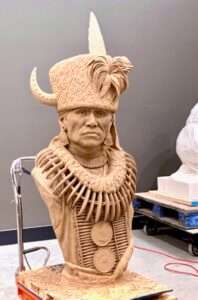
By CINDY GONZALEZ
Nebraska Examiner
LINCOLN — A tired, 1960s-era government office building is about to be revamped and renamed in recognition of a Nebraska icon whose place in history also has seen a revival of sorts.
Come July, the Executive Building just west of the State Capitol will be officially dedicated as the Chief Standing Bear Justice Administration Building.
New flooring, modern lighting and other updates will be part of the $215,000 interior rehab of the five-story structure at 521 S. 14th St.
But upon entering the building, workers and visitors will see the more artistic and dramatic reminders of the tragedy-to-triumph story behind the building’s namesake.

Pivotal points in Standing Bear’s journey
Those elements include a bust of the Ponca chief that was created by sculptor Benjamin Victor and is to be displayed outside the main doors.
A signature mural spanning a main wall just inside the entrance is to be finished in the next few days by artist Sarah Harris. The painting offers passers-by a creative account of pivotal points in Standing Bear’s journey.
It’s those personal touches that thrill Judi gaiashkibos, executive director of the Nebraska Commission on Indian Affairs.
“I’m thrilled because they’re telling a story that is so dear to my heart,” she said. “Not all Nebraskans know the story of Chief Standing Bear.”
She said it seems so “absolutely appropriate” that the mural and the Chief Standing Bear memorial are associated with a building devoted to carrying out the operations of justice.
For Harris, who hails from Boise, Idaho, the mural was an inspirational voyage, as well.
Harris collaborated with Victor early on and had creative license to portray key moments from the chief’s life, starting with the Ponca Trail of Tears. To show the sadness, Harris used blue tones to paint the forced removal of the Poncas, under guard by U.S. troops, from their Nebraska homeland near the Niobrara River.
Walks some 600 miles to bury his son
After that the viewer’s eye goes to a tragic scene of Chief Standing Bear grieving and holding his son Bear Shield, who was among those in the tribe who died in the aftermath of having to walk some 600 miles to arid Indian Territory in Oklahoma. Harris used monochromatic grays in that frame to capture the feeling of heavy loss, including Standing Bear’s despair over being told he could not return to bury his son in their ancestral lands.
Because Natives were not allowed to leave their reservation without permission, the Army arrested Standing Bear and his followers when he returned to bury Bear Shield’s remains in Nebraska.
“I can only imagine how broken he might feel,” Harris said. “And the design on the ribbon directly behind him — the same we’ve seen historically on his necklace — has been separated or broken apart.”
An abstract Niobrara River on the mural then separates the previous events with Chief Standing Bear standing in a Nebraska Supreme Courtroom for his triumphant 1879 moment. Also pictured are Nebraskans Gen. George Crook and journalist Thomas Tibbles.
Shown in full color in his court scene, Standing Bear gestures with his hand, urging justice. He argued that although the skin of his hand may be a different color, it also bled when pierced. His famous words: “The blood that will flow from mine will be of the same color as yours. I am a man. The same God made us both.”
‘First people deserve to be known’
Judge Elmer Dundy ultimately ruled in favor of Standing Bear, saying in the landmark case that the chief and members of his tribe should be considered “persons” under the law and therefore entitled to the rights of others.
Jason Jackson, director of the Nebraska Department of Administrative Services, said state officials thought Standing Bear was a fitting choice to honor, given that the building’s offices are occupied by professionals who support justice administration throughout the state.
He said the changes at the building are part of a broader initiative to recognize historic Nebraskans as the state upgrades state-owned properties.
At Gov. Pete Ricketts’ request, State Sen. Tom Brewer introduced the resolution to rename the Executive Building as well as the former Woodmen Building at 1526 K St. That structure will be renamed the First Nebraska Administrative Building, after the First Regiment Nebraska Volunteer Infantry that fought for the Union during the Civil War.
The name change hopefully will help spark more discussion about other Native American icons and tribal stories, said gaiashkibos, a member of the Ponca Tribe. She said she’s been in the commission’s executive director position for 27 years, and in more recent years, she has watched the Standing Bear story reach new heights and audiences.
The Legislature, for instance, recently allocated funding for a Standing Bear documentary, and a new southeast Lincoln high school soon will bear the Standing Bear name.

Three years ago, a towering bronze statue of Standing Bear was installed in the U.S. Capitol’s Statuary Hall in Washington, D.C. Each state is allowed two notable residents to honor. The Nebraska Legislature voted to replace sculptures of William Jennings Bryan and J. Sterling Morton with statues of Chief Standing Bear and Willa Cather.
“As more people learn the story, they’re inspired,” gaiashkibos said of Standing Bear. “It’s an opportunity for other tribal stories to be told, as well. Our first people deserve to be known.”




